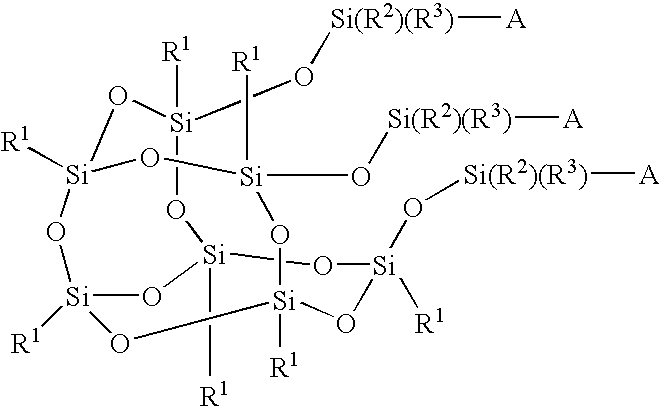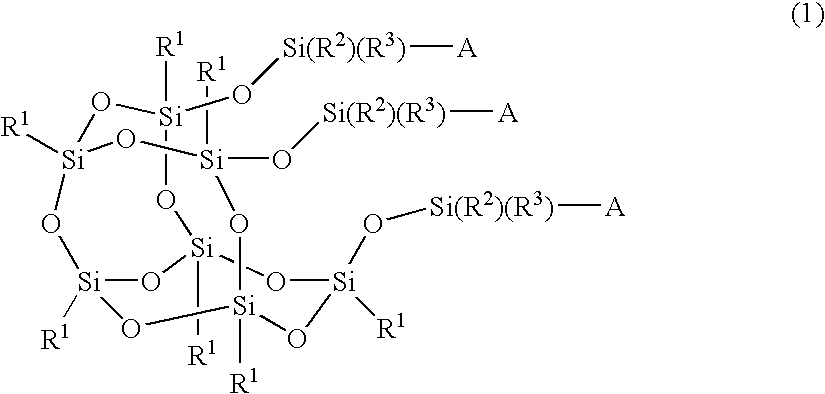Silicon compound
a technology of compound and organic compound, applied in the field of new materials, can solve the problems of difficult control of structure, inability of organic composite materials to do so, etc., and achieve the effects of excellent polymerization initiating ability, and living polymerizability
- Summary
- Abstract
- Description
- Claims
- Application Information
AI Technical Summary
Benefits of technology
Problems solved by technology
Method used
Image
Examples
example 1
[0312]A four neck separable flask having a content volume of 2 liter equipped with a reflux condenser, a thermometer and a dropping funnel was charged with ice and water (640.7 g) and toluene (200 g), and the inside of the flask was cooled to 0° C. while stirring. A mixed solution of phenyltrichlorosilane (211.5 g) And toluene (130 g) dried on molecular sieves for a whole day and nigh was dropwise added thereto in one hour so that a temperature in the inside of the flask did not exceed 2° C., and then the solution was further stirred at a room temperature for 30 minutes. The resulting reaction solution was washed with pure water, and low boiling components were distilled off by heating under reduced pressure to obtain a solid compound (120.7 g). This compound had a weight average molecular weight of about 3100 in terms of polystyrene measured by GPC. This is designated as a compound (A).
[0313]A 500 ml four neck flask equipped with a reflux condenser and a thermometer was charged wit...
example 2
[0314]A four-neck flask of 200 ml equipped with a reflux condenser was charged with the compound (A-1) (2.0 g), toluene (100 g), triethylamine (1.7 g) and trimethylchlorosilane (1.4 g), and the mixture was stirred at a room temperature for 2 hours by means of a magnetic stirrer. After finishing the reaction, it was washed with pure water and dried under vacuum to obtain a compound (2.1 g) into which a trimethylsilyl group was introduced. This is designated as a compound (A-T).
[0315]The compound (A-T) was subjected to structural analysis by means of 1H-NMR, 13C-NMR, 29Si-NMR, mass spectrometry and IR analysis. It was confirmed from a 1H-NMR chart and a 13C-NMR chart that a phenyl group and a trimethylsilyl group were present in an integral ratio of 7:3. It was confirmed from 29Si-NMR that a peak of 11.547 ppm indicating a trimethylsilyl group was present and that three kinds of peaks of −77.574 ppm, −78.137 ppm and −78.424 ppm (all based on tetramethylsilane) indicating a T structure...
example 3
[0317]A three neck flask having a content volume of 50 ml equipped with a dropping funnel and a thermometer was charged with a rotator, the compound (3-2-1) (15.0 g) obtained by making use of the method in Example 1 and THF (85 g), and the flask was sealed with dry nitrogen. Dimethylchlorosilane (12.8 g) was dropwise added thereto from the dropping funnel in about 10 minutes while stirring by means of a magnetic stirrer. In this case, the dropping speed was controlled so that the content did not exceed 40° C. After finishing dropwise adding, stirring was continued at a room temperature for 3 hours to complete the reaction. Then, 30 g of pure water was added thereto while paying attentions so that the content did not exceed 40° C. to hydrolyze unreacted dimethylchlorosilane and dissolve sodium chloride. The reaction mixture thus obtained was transferred into a separating funnel to separate an organic layer from an aqueous layer. The organic layer thus obtained was washed with saturat...
PUM
| Property | Measurement | Unit |
|---|---|---|
| temperature | aaaaa | aaaaa |
| temperature | aaaaa | aaaaa |
| temperature | aaaaa | aaaaa |
Abstract
Description
Claims
Application Information
 Login to View More
Login to View More - R&D
- Intellectual Property
- Life Sciences
- Materials
- Tech Scout
- Unparalleled Data Quality
- Higher Quality Content
- 60% Fewer Hallucinations
Browse by: Latest US Patents, China's latest patents, Technical Efficacy Thesaurus, Application Domain, Technology Topic, Popular Technical Reports.
© 2025 PatSnap. All rights reserved.Legal|Privacy policy|Modern Slavery Act Transparency Statement|Sitemap|About US| Contact US: help@patsnap.com



